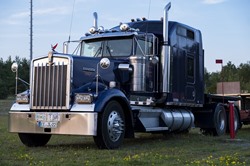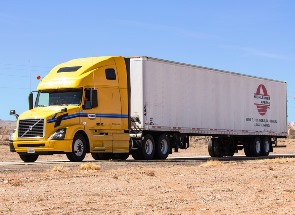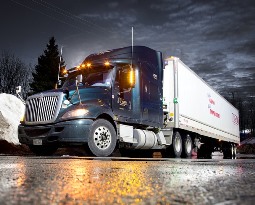How to Select the Best Trucking School near Capitol Montana
 Congratulations on your decision to become a truck driver and enroll in a truck driving school near Capitol MT. Maybe it has always been your ambition to hit the open road while driving a huge tractor trailer. Or perhaps you have conducted some analysis and have discovered that a career as a truck driver offers good income and flexible work opportunities. Whatever your reason is, it’s essential to obtain the proper training by picking the right CDL school in your area. When reviewing your options, there are various variables that you’ll need to consider before making your final selection. Location will no doubt be important, especially if you need to commute from your Capitol residence. The expense will also be important, but selecting a school based solely on price is not the optimal way to make sure you’ll receive the right education. Just remember, your objective is to master the knowledge and skills that will allow you to pass the CDL exams and become a professional truck driver. So keeping that target in mind, just how do you choose a truck driving school? That is what we are going to cover in the remainder of this article. But first, we are going to talk a little bit about which commercial driver’s license you will ultimately need.
Congratulations on your decision to become a truck driver and enroll in a truck driving school near Capitol MT. Maybe it has always been your ambition to hit the open road while driving a huge tractor trailer. Or perhaps you have conducted some analysis and have discovered that a career as a truck driver offers good income and flexible work opportunities. Whatever your reason is, it’s essential to obtain the proper training by picking the right CDL school in your area. When reviewing your options, there are various variables that you’ll need to consider before making your final selection. Location will no doubt be important, especially if you need to commute from your Capitol residence. The expense will also be important, but selecting a school based solely on price is not the optimal way to make sure you’ll receive the right education. Just remember, your objective is to master the knowledge and skills that will allow you to pass the CDL exams and become a professional truck driver. So keeping that target in mind, just how do you choose a truck driving school? That is what we are going to cover in the remainder of this article. But first, we are going to talk a little bit about which commercial driver’s license you will ultimately need.
Which CDL Will You Need?
 To operate commercial vehicles legally within the USA and Capitol MT, a driver must attain a CDL (Commercial Driver’s License). The three classes of licenses that one can apply for are Class A, Class B and Class C. Since the topic of this article is how to pick a truck driving school, we will address Class A and B licenses. What differentiates each class of CDL is the kind of vehicle that the driver can operate as well as the GVWR (Gross Vehicle Weight Rating) or GCWR (Gross Combination Weight Rating). Below are brief summaries of the 2 classes.
To operate commercial vehicles legally within the USA and Capitol MT, a driver must attain a CDL (Commercial Driver’s License). The three classes of licenses that one can apply for are Class A, Class B and Class C. Since the topic of this article is how to pick a truck driving school, we will address Class A and B licenses. What differentiates each class of CDL is the kind of vehicle that the driver can operate as well as the GVWR (Gross Vehicle Weight Rating) or GCWR (Gross Combination Weight Rating). Below are brief summaries of the 2 classes.
Class A CDL. A Class A CDL is required to drive any vehicle that has a GCWR of greater than 26,000 lbs., including a towed vehicle of greater than 10,000 lbs. Some of the vehicles that drivers may be able to operate with Class A licenses are:
- Interstate or Intrastate Tractor Trailers
- Trucks with Double or Triple Trailers
- Tanker Trucks
- Livestock Carriers
- Class B and Class C Vehicles
Class B CDL. A Class B CDL is needed to operate single vehicles having a GVWR of greater than 26,000 lbs., or a GCWR of greater than 26,000 lbs. including a towed vehicle weighing up to 10,000 lbs. A few of the vehicles that operators may be qualified to drive with Class B licenses are:
- Tractor Trailers
- Dump Trucks
- Cement Mixers
- Large Buses
- Class C Vehicles
Both Class A and Class B Commercial Drivers Licenses might also require endorsements to operate certain kinds of vehicles, including school or passenger buses. And a Class A license holder, with the appropriate required endorsements, can operate any vehicle that a Class B license holder is authorized to operate.
Click Here to Get Free Information on Truck Driving Schools Near You!
How to Assess a Truck Driving School
 Once you have decided which CDL you would like to obtain, you can begin the process of assessing the Capitol MT truck driver schools that you are looking at. As previously discussed, location and cost will undoubtedly be your initial considerations. But it can’t be emphasized enough that they should not be your only concerns. Other variables, such as the reputations of the schools or the experience of the instructors are similarly if not more important. So below are several more factors that you should research while carrying out your due diligence prior to choosing, and particularly paying for, your truck driving training.
Once you have decided which CDL you would like to obtain, you can begin the process of assessing the Capitol MT truck driver schools that you are looking at. As previously discussed, location and cost will undoubtedly be your initial considerations. But it can’t be emphasized enough that they should not be your only concerns. Other variables, such as the reputations of the schools or the experience of the instructors are similarly if not more important. So below are several more factors that you should research while carrying out your due diligence prior to choosing, and particularly paying for, your truck driving training.
Are the Schools Certified or Accredited ? Very few truck driving schools in the Capitol MT area are accredited due to the rigorous process and expense to the schools. However, certification is more typical and is offered by the Professional Truck Driver Institute (PTDI). A school is not required to become certified, but there are several advantages. Prospective students know that the training will be of the highest caliber, and that they will be given an ample amount of driving time. For example, PTDI requires 44 hours of actual driving time, not simulations or ride-alongs. So if a school’s program is certified (the program, not the school is certified), students know that the curriculum and training will measure up to the very high benchmarks set by PTDI.
How Long in Operation? One indicator to help determine the quality of a trucking school is how long it has been in operation. A poorly reviewed or a fly by night school typically will not be in business very long, so longevity is a plus. On the other hand, even the top Capitol MT schools had to start from their opening day of training, so use it as one of several qualifications. You can also learn what the school’s history is pertaining to successful licensing and employment of its graduating students. If a school won’t provide those numbers, search elsewhere. The schools should additionally have relationships with local and national trucking firms. Having numerous contacts not only confirms an excellent reputation within the trade, but also boosts their job placement program for graduates. It also wouldn’t be a bad idea to contact the Montana licensing department to make sure that the CDL trucking schools you are reviewing are in good standing.
How Good is the Training? At a minimum, the schools should be licensed in Montana and hire instructors that are trained and experienced. We will cover more about the teachers in the following section. Also, the student to instructor proportion should be no greater than 4 to 1. If it’s any higher, then students will not be receiving the personalized instruction they will need. This is especially true regarding the one-on-one instruction for behind the wheel training. And watch out for any school that claims it can teach you to drive trucks in a relatively short time period. Training to be a truck driver and to drive a tractor trailer skillfully takes time. The majority of Capitol MT schools offer training courses that range from 3 weeks to as long as 2 months, depending on the class of license or type of vehicle.
How Good are the Trainers? As previously stated, it’s imperative that the instructors are qualified to teach driving techniques and experienced as both instructors and drivers. Even though several states have minimum driving time requirements to be certified as an instructor, the more professional driving experience an instructor has the better. It’s also important that the instructors stay up to date with industry advancements or any new laws or changes in regulations. Evaluating instructors might be a bit more intuitive than other criteria, and possibly the ideal method is to check out the school and speak with the teachers face to face. You can also speak with a few of the students completing the training and find out if they are satisfied with the level of instruction and the teacher’s qualification to train them.
Sufficient Driving Time? Above all else, a good trucking school will provide lots of driving time to its students. Besides, isn’t that what it’s all about? Driving time is the actual time spent behind the wheel operating a truck. While the use of simulators and ride-a-longs with other students are important training methods, they are no replacement for actual driving. The more training that a student gets behind the wheel, the better driver he or she will be. Although driving time fluctuates among schools, a good standard is 32 hours at a minimum. If the school is PTDI certified, it will furnish no less than 44 hours of driving time. Contact the Capitol MT schools you are researching and ask how much driving time they provide.
Are they Captive or Independent ? You can receive discounted or even free training from certain truck driver schools if you enter into an agreement to be a driver for a specified carrier for a defined amount of time. This is referred to as contract training, and the schools that provide it are called captives. So rather than maintaining relationships with numerous trucking lines that they can refer their students to, captives only refer to one company. The tradeoff is receiving free or less expensive training by surrendering the flexibility to initially work wherever you have an opportunity. Obviously contract training has the potential to limit your income prospects when starting out. But for some it may be the best way to obtain affordable training. Just make sure to inquire if the Capitol MT schools you are looking at are independent or captive so that you can make an informed decision.
Offer Onsite CDL Testing? There are several states that will permit 3rd party CDL testing onsite of trucking schools for its graduates. If onsite testing is permitted in Montana, ask if the schools you are reviewing are DMV certified to provide it. One advantage is that it is more convenient than competing with graduates from other schools for test times at Montana testing facilities. It is also an indication that the DMV believes the authorized schools to be of a superior quality.
Are the Class Times Flexible? As formerly mentioned, truck driving training is only about one to two months in length. With such a short term, it’s important that the Capitol MT school you select provides flexibility for both the curriculum and the scheduling of classes. As an example, if you’re having a hard time learning a certain driving maneuver, then the teacher should be prepared to dedicate more time with you until you are proficient. And if you’re still employed while going to training, then the class scheduling needs to be flexible enough to accommodate working hours or other commitments.
Is Job Assistance Offered? The moment you have obtained your commercial driver’s license after graduating from trucking school, you will be anxious to begin your new profession. Verify that the schools you are contemplating have job assistance programs. Find out what their job placement percentage is and what average salary their grads start at. Also, ask which local and national trucking companies their graduates are referred to for employment. If a school has a low job placement rate or not many Capitol MT employers recruiting their graduates, it may be a sign to search elsewhere.
Is Financial Assistance Given? Truck driver schools are comparable to colleges and other Capitol MT area trade or technical schools when it comes to loans and other forms of financial aid being available. Ask if the schools you are assessing have a financial aid department, or at least someone who can help you navigate the options and forms that must be completed.
How Can I Get My CDL License Capitol Montana
 Picking the right truck driving school is an important first step to beginning your new vocation as a local or long distance truck driver. The skill sets that you will learn at school will be those that mold a new career behind the wheel. There are many options offered and understanding them is critical to a new driver’s success. You originally came to our website because of your interest in How Can I Get My CDL License and wanting information on the topic CDL Drivers License Training. But first and foremost, you must get the appropriate training in order to drive a big commercial vehicle in a professional and safe fashion. If you are lacking cash or financing, you might need to look into a captive school. You will pay a lower or in some cases no tuition by agreeing to drive for their contracted carrier. Or you can enroll in an independent trucking school and have the option of driving for the trucking company of your choosing, or one of many associated with the school. It’s your decision. But regardless of how you receive your training, you will soon be joining an industry that helps America move as a professional trucker in Capitol MT.
Picking the right truck driving school is an important first step to beginning your new vocation as a local or long distance truck driver. The skill sets that you will learn at school will be those that mold a new career behind the wheel. There are many options offered and understanding them is critical to a new driver’s success. You originally came to our website because of your interest in How Can I Get My CDL License and wanting information on the topic CDL Drivers License Training. But first and foremost, you must get the appropriate training in order to drive a big commercial vehicle in a professional and safe fashion. If you are lacking cash or financing, you might need to look into a captive school. You will pay a lower or in some cases no tuition by agreeing to drive for their contracted carrier. Or you can enroll in an independent trucking school and have the option of driving for the trucking company of your choosing, or one of many associated with the school. It’s your decision. But regardless of how you receive your training, you will soon be joining an industry that helps America move as a professional trucker in Capitol MT.
Truck On in These Other Montana Locations
Washington State Capitol
The Washington State Capitol or Legislative Building in Olympia is the home of the government of the state of Washington. It contains chambers for the Washington State Legislature and offices for the governor, lieutenant governor, secretary of state and treasurer and is part of a campus consisting of several buildings. Buildings for the Washington Supreme Court, executive agencies and the Washington Governor's Mansion are part of the capitol campus.
After Olympia became capital city of the Washington Territory in 1853, the city's founder, Edmund Sylvester, gave the legislature 12 acres (4.9 ha) of land upon which to build the capitol, located on a hill overlooking what is now known as Capitol Lake. A two-story wood-frame building was constructed on the site, where the legislature met starting in 1854.[1] When President Benjamin Harrison approved Washington's state constitution in 1889, he donated 132,000 acres (530 km2) of federal lands to the state with the stipulation that income from the lands was to be used solely for construction of the state capitol.[2]
The legislature formed the State Capitol Commission in 1893 to oversee the creation of a new capitol on the property in Olympia. The commission had a nationwide competition to find an architect and chose the submission of Ernest Flagg. Construction began on Flagg's plan, but was soon stalled by poor economic conditions with only the foundation completed. When the legislature finally approved an appropriation of additional funds in 1897, newly elected Governor John Rogers vetoed it. Rogers advocated the purchase of the existing Thurston County Courthouse in downtown Olympia, now known as the "Old Capitol" and home to the Office of Superintendent of Public Instruction. The legislature approved the new location and began meeting there in 1905.
